Born 30 June 1919, in Buffalo, NY the 11th largest city in the United States at that time.
1919 was the year of the Polish-Soviet War, the year the Fascist Party was formed, the year of the Amritsar Massacre, the year suffrage was guaranteed to American women, and the year they experimentally confirmed Einstein’s Theory of General Relativity.
The world was recovering from the Spanish flu epidemic as well as the horrors of the First World War. Buffalo had had strict, some said “draconian” lockdown measures put in place when their flu cases spiked in the Fall of 1918 and winter 1919, and, for that reason, they escaped better than most of the country. Though I have no stories of family members who had the flu, during the epidemic, Robert’s father’s brother, Uncle George Kieber, fled to California, changed his name to Smith, and was hardly heard from after that.
Note: where I have quoted directly from some writing that Robert left behind, or from a story he told, I have used italics.
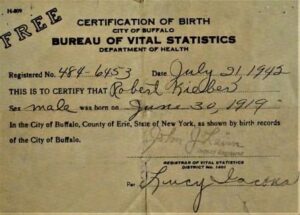 He was the youngest of 42-year old, John and Anna T Ruhland Kieber’s five children. He described his father as a kindly man, even though he never told Robert that he loved him. His Mom was stern and stoic. His Dad cleaned the insides of steam locomotives by removing the excess coal from the storage bin. Buffalo was a major rail hub at the time and the railroads employed 20,000 men.
He was the youngest of 42-year old, John and Anna T Ruhland Kieber’s five children. He described his father as a kindly man, even though he never told Robert that he loved him. His Mom was stern and stoic. His Dad cleaned the insides of steam locomotives by removing the excess coal from the storage bin. Buffalo was a major rail hub at the time and the railroads employed 20,000 men.
In Robert’s words, He respected his parents even though they were working class and not educated.
Bob said he didn’t know much about his grandparents. His mother’s father, the Bavarian, Georg Ruhland died before he was born and Gramma Anna Ruhland died in 1931 when Bob was 11 years old.
His Alsatian grandfather, the immigrant, Fritz Kieber, also died before Robert was born, in 1895 of pneumonia. His gramma, Fritz’ wife (another immigrant), Lena Grimm Kieber died in 1932, when he was 12. Bob also had pneumonia twice as a youngster, as did great-grandson Devin.
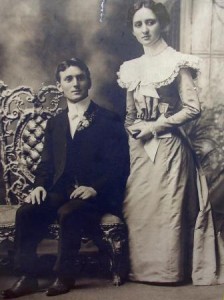
St. Ann’s RC Church
Buffalo NY
Robert grew up in a poor family. They were renting a duplex that was shared with the Wendts at 131 Bissell Avenue, Buffalo in 1917.
But they were living, I think by time Bob was born, and perhaps because of the addition to the family, at 126 May Street Buffalo New York. At least, they are listed on the 1920 US census. His parents were 43 years old and rented a home at in the Emerson area of Buffalo. John’s parents spoke French and were from Alsace-Lorraine; Anna’s spoke German from Germany. Interestingly, John says his mother-tongue is French and Anna’s is German. John was a motorman for a streetcar. Raymond is a clerk.
This home was built in 1900, of traditional style with a partial basement, 1,855 sq.ft., 2 bathrooms, 4 bedrooms. Current value, $17,000. Not really sure how this jives with what there is on Redfin! According to Redfin, this 1,855 square foot vacant land is a 2,460 square foot lot and features 4 bedrooms and 2 baths. The 2019 assessment was $2,500. Less than the price of a used car!
The 1923 Buffalo Directory, the Kiebers had moved to 616 E. Amherst. I am not sure that this is correct, or perhaps the numbering changed. At any rate, this house was next door to where the family moved by 1925. John was working as a metalworker. Raymond was a Bookkeeper at McDougall-Butler, and Florence was a telephone Operator.
By 1924, John had secured a position as foreman.By 1925, according to the NY census, Bob was 6 years old, the family had moved to what would be known as the family home, 2.5 miles north on Bailey Ave. into the Kensington area: 620 E. Amherst St. (3 houses in from Bailey). This was Buffalo’s Ward 20 in the northeastern part of the city.
In 2021 the Zillow estimate for this house was $60,000. The house was built in 1922. His parents remained in this house until they died. It has 3 bedrooms and one bathroom, and it’s 1,428 sq. ft. Seven of them lived there. His dad, 48 yr., was working as a Machinist; Raymond, 23 yr. as a bookkeeper; Buddie, 19 had begun work as a telephone operator. Clarence, 14, had begun high school, and Lavern, 8, and Robert, 6, were in school.
There is a garage in the back.
Cousin Kris remembered the layout of the house from her many visits to her grandparents when they were alive. There was an enclosed front porch when you first entered the house. The stairs were nearly right in front of front door. Upstairs was a bedroom where Kris thinks she used to nap as a child on a big brass bed. There was a dresser with a comb and brush set and a button hook on it. Perhaps this was Bob’s room as a child!
On the main level, there were stairs off the kitchen down to the side door into the house. And to the right of the kitchen was the dining room.
When Marie and Tom lived at 394 Hewett Avenue (near Bailey) in the 1980s, Bob visited and explained the set-up of the house he grew up in, which was exactly the same plan as the Hewett house! Heated by forced air from a pot-bellied coal furnace. The first window into the basement on the side of the house was the coal chute. Dad had to pick up the coal from the railroad tracks since they could not afford coal during the depression. Some nice people from the train would see him waiting there and would throw him some.
As with most children of his generation, he had regular chores around the house. Robert’s chore was taking the coal ashes out of the furnace and sifting through them to recycle coal pieces.
Another chore was scooping up the horse’s poop when the milk truck driven by one of his Ruhland uncles or cousins, when they stopped in front of the Kieber house. The manure was used in the gardens. Perhaps Bob’s interest in gardening stemmed from this period. For more info. see part 3.
The milk would be delivered to the back door area called the milk cabinet, which opened to both the outside and the inside, where it would stay fresh until the house wife picked it up.
And yet another chore for Bob was when the ice guy would deliver ice to the house, it was Bob who was the one to stack it. These chores fostered a sense of belonging and contributing to the household. They cemented the family relationships.
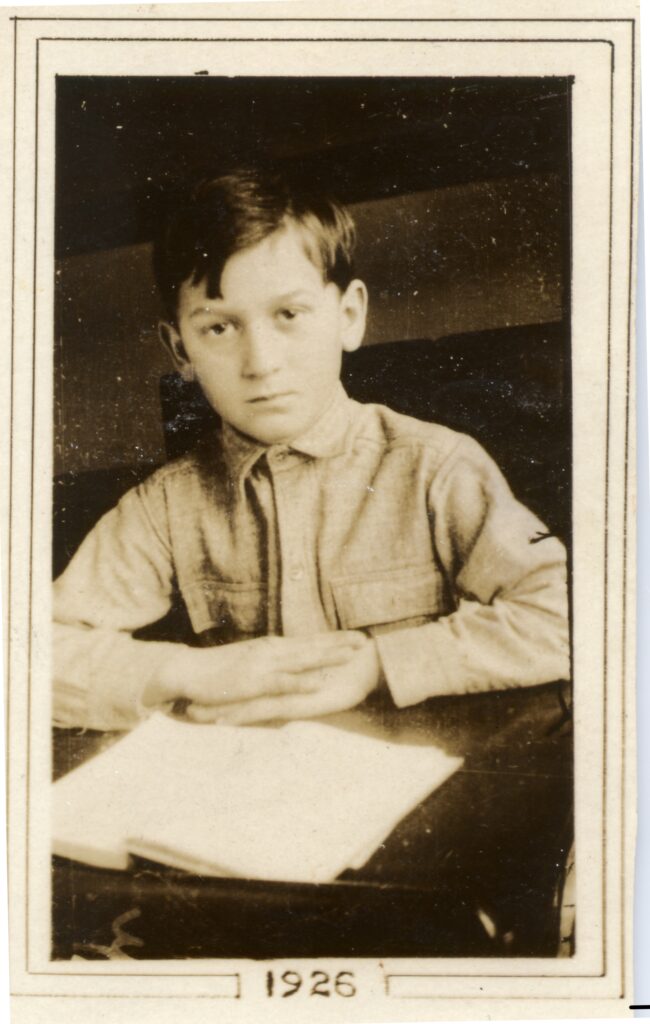
Bob said the The Kensington area was nearly open country of farms and forest when the family settled there. But it didn’t remain that way for long. Area farms were selling to developers and broken into plots. Robert talked about seeing this happen while he was growing up.
“Bailey/Kensington North
The northern district of the Kensington/Bailey area was amongst the last areas within the city limits to be developed. Although trolley service was introduced to the area in August, 1895, the lands north of Kensington Avenue changed little for many years after.
As late as the 1920s, the area east of Bailey and north of Kensington retained its rural character. As with other sections of the city, it was often the house of worship which formed the first visible mark upon the landscape.
With the arrival of trolley service, the intersection of Bailey and Kensington began to change. The greatest impact was seen after World war I when the Kinsey Realty Company, developer of much of the area, noted that the value of property on the corner increased from $2,500 to $25,000 in one year’s time.” (https://buffaloah.com/h/kenbailey/kenbailey.html)
In 1915, new streetcar tracks were laid on Kensington and Grider. The population more than doubled in the 1920s with Italian and Polish immigrants now joining the Germans who continued to populate the area. (Chuck LaChiusa, “Buffalo Architecture: A Guide.” Cambridge: MIT Press, 1981)
For history see, https://buffaloah.com/h/kenbailey/kenbailey.html
In the 1926 Buffalo Directory, Bob’s dad, John, is listed as a shopman at Champion Switch Company. On 26 July 1926, when Bob was 7 years old, his eldest brother, Raymond, married Elisabeth “Elsie” Eimiller. They lived at 210 Millicent Ave., Buffalo, which was only .8 mile from the Family on East Amherst St.

Unfortunately, the Great Depression struck in October 1929 (continued until 1939). Buffalo’s working class experienced severe unemployment. The New Deal was in full force, but still, there was much labor unrest, particularly, but not limited to Lackawanna Steel. Eventually, the city became a stronghold for labor unions. Before Robert was born, his Dad, John was a driver (motorman) for a horse-drawn streetcar (the IRC) and during this time he participated in the Great Strike (1899). Though this was before Bob was born, the attitude of justice for workers, which was fostered in local Catholic churches, may have had an impact on him, who, many years later (see part 3) would advocate for unionizing the teachers at the Catholic school where he taught.
The Kieber family was no exception to Depression era woes. The economic troubles they already had were compounded when John lost his job. Bob said, luxuries were things he heard about, but did not experience.
On the 1930 US census, his Dad had become a Foreman in the yard for the Steam Locomotive. His sister, Buddie was a telephone operator, and brother Clare worked as a knitter in the knitting mill. Bob told a story that his Dad had a friend who worked in the railyard and told him there was a job opening. John knew nothing about the work and was not experienced — perhaps the friend was going to teach him — at any rate, he bluffed his way in and, thankfully for the family, got the job.
Bob’s family were active members of St.James Roman Catholic parish. His Dad belonged to the Holy Name Society. St. James at 3021 Bailey Ave. was founded in 1917 for the rapidly growing German/Irish community. He spoke of going into the basement for Sunday Mass for many years because construction to the rest of the building progressed very slowly due to lack of funding, the Depression, etc. The plan was to build the church on top of the basement. According to cousin Lynn, Bob’s Aunt Buddie’s daughter, who attended St. James for many years, this was the only Buffalo church where one had to walk DOWN the stairs to enter. Many members of the family attended St. James over the years, including Marie Kieber, who lived on Virgil Avenue in the early 1980’s. See bottom of page for links and photos of St. James. The final Mass at St. James church was offered in 2007. A history of the church is provided, originally from the Preservation Buffalo Niagara and is reprinted by James Napora here.
According to Wikipedia: it was an unusual-looking Gothic Revival-style building with an enormous, deeply recessed portal dominating the front façade. Interior of church was renovated 1980[3] but parish population began to decline soon after; shared a pastor with St. Gerard parish for last two years of its existence.[130] After closure of church, building served for a time as a food pantry;[131] now home to a Baptist church serving the local Karen refugee community.[132] |
St James Catholic Elementary School at 10 Hastings Avenue and graduated on 25 Jun 1933. St. James closed its doors on 30 June 1988. Today, the school is the NativityMiquel School of Buffalo St. Augustine Campus –an all boys campus. From the Nativity website: “The NativityMiguel Middle School is a faith-based middle school transforming the lives of underserved students in a secure and nurturing environment on single gender campuses.”

The picture is of a statue Dad was given by his mother on the occasion of his First Holy Communion. He kept it on his bedside table until he died. Though we don’t have the records yet, he should have made his Communion in 1926, when he was 7 years old.
He grew up with a feeling of being diferent, since he was Catholic. Catholics were marginalized at this time. Bob always felt that his religion made him stand apart. His strong, ethical, Catholicity that he felt called to a higher standard of conduct.
The family paid strict adherence to fasting and other religious observance, such as fish for Friday dinners, which Robert kept up when he had his own family. This doesn’t seem like much now, but at that time, red meat and potatoes were the usual fare for evening meals. Also, there was no eating after midnight, until after attending Sunday Mass, which could be noon. Cousin Kris Nordby remembers always having kuchen or donuts after Mass. To me, it always felt like a reward for having gone to Mass, but of course, you were extra hungry since you had skipped breakfast.
Because Lent is a time of self-reflection and abstinence, Anna made Fastnacht Kuecheles on Fat Tuesday before the “giving up” period started. Like his brother, Lavern, Bob’s eyes would light up when he recounted how delicious they are! Kris still sometimes makes them.
As I said, Bob’s ethical sense was very strong. He once commented that his father was “strict about accepting people for their character.” He believed in right and wrong and not in situational ethics as is common for most of us today. Much later in his life, he felt his greatest failure as a father was that his own children were not all practicing Catholics.
The family kept many of the old German traditions. There are a couple of different accounts, probably due to differing time periods in his life for the St. Nicholas Day traditions. One was that his Dad made fudge. candy (Kris tried making and it never turned out). Marie has the fudge recipe. She said that it was not very good, at least not like the buttery type of fudge we like today. It was more crystalline. I guess we’ll just have to try it to find out for ourselves! The night before St. Nick Day, which is always December 6, each child put a pair of shoes outside of their bedroom door. In the morning, they’d find fudge in each shoe. Sue remembered Dad saying that he would receive oranges in his shoes. Kris said it was candy, nuts, and an orange. By the time, we continued the practice with our own children, we put small toys or books and oranges in their shoes.
Bob’s ancestors were not only farmers (Kiebers as well as Ruhlands), but also linen weavers and tailors (Kiebers) in Alsace. He learned at a young age to sew. When grandson, Nathaniel learned to sew and enjoyed making a work apron for himself, Bob commented that he had really enjoyed sewing as a youngster. His mother, Anna, made many doilies etc. also taught him how to tatt, which is similar to making lace. You can see a photo at the bottom of this page of Robert sitting in a chair at home with his mother’s antimacassars.
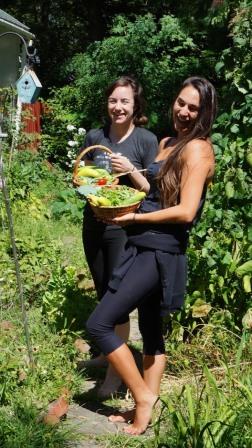
His dad, John, worked six days a week. On Sundays, the family took long drives to farm stands, or to pick fruit along Lake Erie shores, or visit the reservation, or the aunts and uncles. For instance, Bob talked about visiting the Leib farm, home of his Dad’s sis, 2 years younger, Emma Kieber Leib, her husband and their 3 boys. The families would visit, and in exchange for John’s homemade wine, they would receive baskets of fresh produce. Bob recalled not really liking going there since, for some reason, it was always so boring. They also visited John’s brother, 5 years younger, Martin and his wife, Lena, who had a farm in Burt, then in East Otto NY. Kris remembers visiting that farm.
Kris’ dad, Uncle Clare, told them stories of the family visiting farms, and even spending some time there each summer. She particularly remembered one where Clare and Uncle George (his cousin on the Ruhland side), so it must have been a Ruhland farm they were visiting, probably the Franks.
Photo: Annie and Aly visiting the Grady garden in October 2017 and filling baskets of veggies to take home to Cleveland. “It’s like our own CSA” they said.
They also went to Beaver Island which was a big beach on Grand Island.
Dad told the story of his Mom falling into the swiftly-flowing Niagara River, from Goat Island (I think that’s where). Anna could not swim! Bob, who was a young boy, and could swim, quickly jumped in and was able to pull her out.
Robert was fond of telling stories of his time spent on the Cattaraugus Indian reservation, south of Buffalo. His Dad loved his Sunday drives and they’d go to the Res. for farm produce as well. They came to know a woman who lived alone with her two sons. The Kiebers would help out with the farm chores and attend Pow-Wows with them. As so many in western new york at the time, they had a bull and dairy cows. Dad seemed to love churning butter for her. He chuckled and mentioned how his brother, Lert, who’d later become a Roman Catholic priest, would sit in the corner and read. But not Dad, he’d go off with one of the sons who was his age, and they’d go hunting. The Seneca boy would pray over the animal he just killed. Dad found that foreign and kind of exotic. The Senecas, he said, were so alien to his strict German Catholic upbringing: the dirt floors of their home, the fact that they didn’t go to church, the food they ate. As Bob said later, they dressed different, ate different, talked different from the German family he was growing up in; it was like visiting a different country. But he was awfully fond of his buddie and I’m guessing, sad, when he was in high school and they stopped going out to the res. There had been a murder on the res. (a person had been shot) and his mother became jumpy. Our Corn Relish recipe came from this family.
Bob’s Dad, John, also hunted rabbit. Mike remembers how Bob said his father would send a ferret into a rabbit hole to chase the rabbit out and then John was able to kill it. When I researched this method, I was surprised to find that it is still practiced and there are even hunting tours in Europe you can go on if you would like to try your hand at a traditional practice.
Bob did talk about traditional German rabbit stew called Hassenpfeffer. Bob’s brothers’ wife, Georgia, loved loved hassenpfeffer. Clare raised rabbits for a while they were growing up. I do not have a recipe for rabbit stew, but there are plenty online. That was never something we did ever enjoy or even try. Mike remembers his family tried to make Hassenpfeffer once and “it was hard to get all of the hair off the animal…it was quite disgusting!”

Remember, his Dad had a stern side, and as a punishment, Bob said his father locked him in a closet. He remained fearful of the dark throughout his life because of this.
Ever since he was a child, Bob hated lamb. Perhaps this was because his mother made it for dinner one night and his dad, who must’ve had a bit of a temper, came home from work, sat at the table, and said I am not going to eat this garbage. Then he proceeded to throw it out the window and told Anna to make him something decent for dinner.
On the other hand, the Ruhlands were known as wonderful cooks and bakers, including Bob’s Mom. There never was a meal without a pie that Anna had made, Grandpa John insisted upon this. maybe she didn’t have one….. See some of her recipes that have been handed down, many continuing to be made by her grandchildren today. The cousins remember that whenever they stopped by “Gramma’s” house, she would have some freshly baked cookies for them. Marie continues this tradition with her grandchildren. Anna also made a famous Brown Cake and a War Cake. Would love to know if anyone has tried these recipes — or finds the actual recipe for the war cake. In the meanwhile, there are several tasty looking recipes that can be found online. Bob’s wife, Pris continued the Saturday night Baked Beans tradition, using Anna’s recipe. Kris remembers Gramma Annna making springerle ….The Grady family continues Anna’s legendary Potato Pancakes, though don’t think she had a written vesion, we use this one.
Both the Ruhlands (Anna had 12 siblings) and the Kiebers (Bob’s dad, John had 9 siblings) were large families, so there were LOTS of aunts, uncles, and cousins in the Buffalo area. Since Dad was the baby of his family (eldest child, Raymond, was born 18 years before Bob in 1901) his mother, Anna would take him to the grocery store. They walked the few blocks and on the way home, they would stop off at Aunt Frances Frank’s (Anna’s sister) home. The adults would gossip and have coffee while Dad played.
The Kieber – and Frank families in Buffalo remained close for many years. Bob’s brother, Clarence’, kids would grow up next to Francis Frank’s son, George. George’s kids were like siblings to them. Linda still visits Karen!
Photo at left is from one of the Kieber family reunions at the Hartwig cottage in the fifties. Bob’s Dad, John is on the far right, trying on his Mom’s Alsatian clothing for a family skit. He is with his brother, Fred, and brother-in-laws, Emmons Perkins, Elmer Leib.
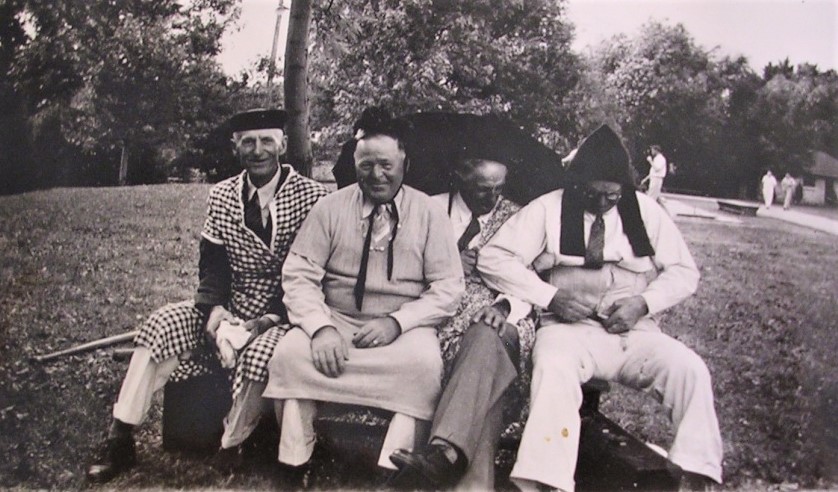
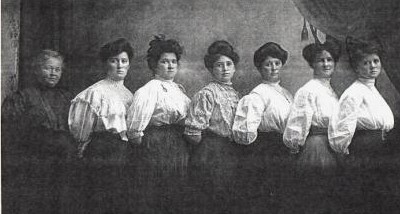
Robert’s family always had huge vats of wine down in the cellar. John had 20 barrels in the basement for his delicious home-brewed beer and wine. Karen Kieber Bartz recalled the huge fruit press in the basement of the house on Amherst street. There were always friends of his mother, Anna, sitting around on Sundays sipping on Elderberry wine. The aunts and uncles who lived on farms would bring over baskets of fruit or vegetables and leave with a jug of wine. Bob was amazed at how his father, who was a relatively uneducated man, knew how to get the chemistry right for making wine. He said that he never messed it up. Every batch his Dad made was good!
Picture above is Bob’s gramma, Anna Ruhland and then his Mom, Anna Theresa Ruhland Kieber with sisters, Theresa, Eva, Frances, Augusta (Girlie) and Dora.
As mentioned earlier, Robert recalled going to the reservation or along Lake Erie to pick fruit for the elderberry (the women usually drank this), chokecherry (the men seemed to enjoy this best), grape, or other wines. They thought that anybody could make grape wine but you couldn’t buy the specialty fruit wines that the Kiebers made! They also made root beer and draft beer.
Prohibition lasted from January 1920 until December 1933. Producing, importing and transporting alcoholic beverages was outlawed. In Buffalo, home brewers continued nevertheless.

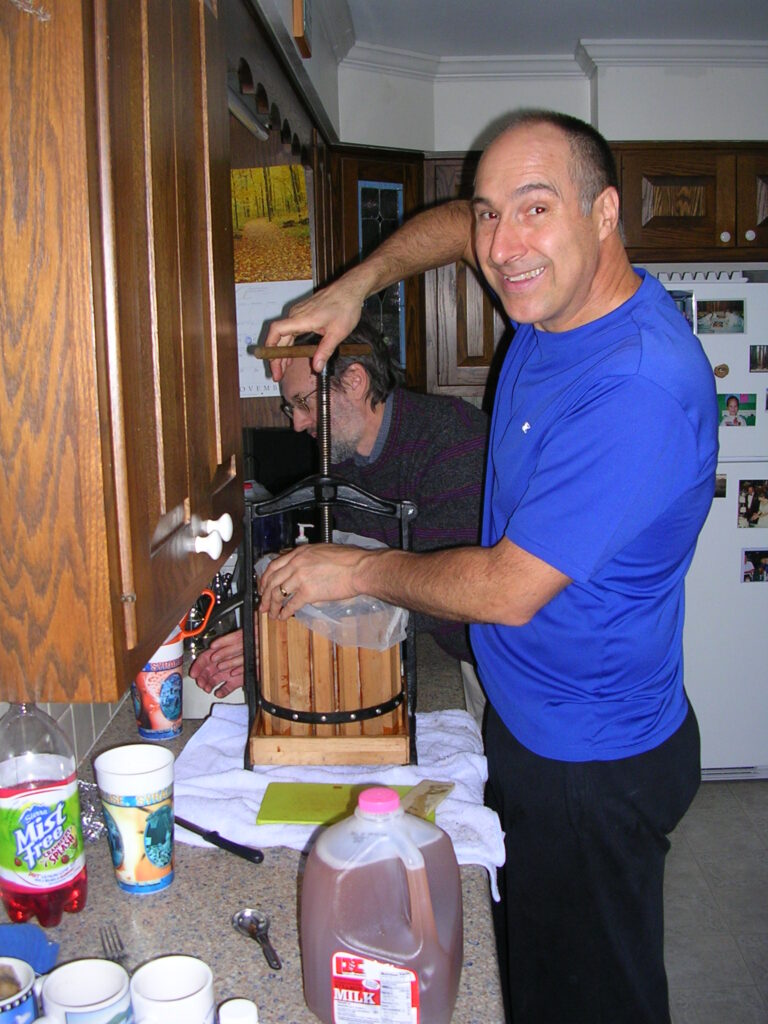
For the family wine-making operation at this time, his Dad hid the sugar in the piano. They stored the alcohol outside beneath the front porch stairs. The neighbors knew that the Kiebers had wine and would come to their house to fill their bottles.
We have the records for the vineyards the family owned in Oberhoffen-lès-Wissembourg. Unfortunately, when we visited a third cousin in Alsace, she no longer knew of anyone in the family making wine. But the tradition continues in the U.S. First with Grampa John Kieber and then with Robert, whose specialty was pear wine, made from pear trees he cultivated in Trumansburg, NY. Tommy enthusiastically remembers Dad’s pear wine, saying “It was the BEST.” I must say, however, that Dave and Mike’s were also quite tasty!
In later generations, the tradition continues — with with California cousin, Duane Leib, who works with 2 friends every year to create small batches of wine. Several more of Bob’s kids continue as well. Dave makes pear wine from his bountiful trees in Manlius NY, and, when he feels generous, he shares a carboy full of juice with his sis! Joe Kieber made enough to supply the wedding party weekend when Ben and Emily got married.
The Grady brothers brewed fantastic beer when they lived in Houston. Perhaps someone else in the family will resume this tradition.
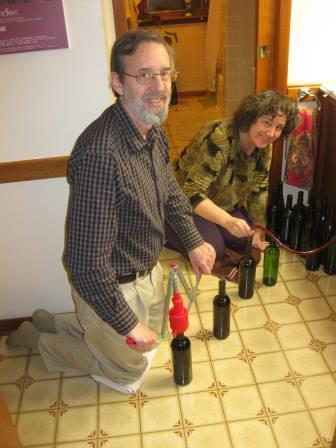

Theresa Ruhland Hoffman and her husband, John Hoffman, were close to Anna and John Kieber. Every Saturday night she and John played pinochle at Anna and John Kieber’s on East Amherst Ave. They would visit the family in Buffalo and Bob would listen to them playing cards from his upstairs bedroom.
Some summers, Bob spent with his Aunt Theresa (Anna’s sis, 1 year younger) and Uncle John Hoffman in Cassadaga NY, purportedly in Lily Dale. Today, Lily Dale is the largest spiritualist community in the US. As so many of the spiritualist religion do, Theresa had a crystal ball on her coffee table. In later years, Bob said that it was simply the fashion and he denied her spiritualist leanings.
After their son, Edwin moved away, Bob went to a Canadian camp on Rice Lake to spend time with his aunt and uncle and go fishing. Bob was very fond of them. He was their fav nephew!
Robert would talk about the difficulties during his school days, since anti-German sentiment was at an all-time high post World War 1. He would be bullied and called nasty names. Kids even threw rocks at him as he walked to school. Though the Kiebers did not do so, many Germans at the time, would change their names so that it was not known they were German. When his older brother Clarence, came back from the Marines, Bob asked him for some advice, and Clare said, “Never show you are scared and if someone starts to bully you, then deck them.” This is what dad did the next time it happened, and you know what, it worked.
An exciting new world of flight was burgeoning during this period. The Wright Brothers had laid the foundation right after the turn of the century. And then, when Bob was 7 years old, in 1927, Charles Lindbergh, the famous aviator who had just flown solo across the Atlantic, visited Buffalo.
As so many youngsters, Bob had a paper route when he was young. He even received a prize for delivering the most newspapers. The prize was a trip to the air show in Cleveland (3 hours and 20 minutes from Buffalo). He was in awe! A love for airplanes and flying gripped him. Soon, he was hanging around the Buffalo airport, watching the planes depart and arrive. Fortunately, in coming years, he was able to attend several more air shows as well and became a pilot in WW2.
From the time he was a youngster in grammar school he wanted to become a bacteriologist. He wanted to study tropical diseases notably African diseases. Perhaps he was influenced by hearing about missionary work in Africa at St. James.
Dad said one of the nicest gifts he ever got was his first chemistry set, and yes, he did have a few explosions in his basement. This is what got him interested in science. He was always sad because his parents never really understood his love for science. They discouraged him from going into it, but after his graduation from Michigan they finally relented. I do not think Dad ever got over their disappointment from them. They would always ask why he could not be like his older brother, Lavern, who became a Catholic priest, and this haunted him. On the other hand, Kris remembers Anna, introducing Bob at John’s funeral, saying “and this is our son, Doctor Robert Kieber.” She made a big deal about it. Our perception of our parent’s views of us may not always be correct!
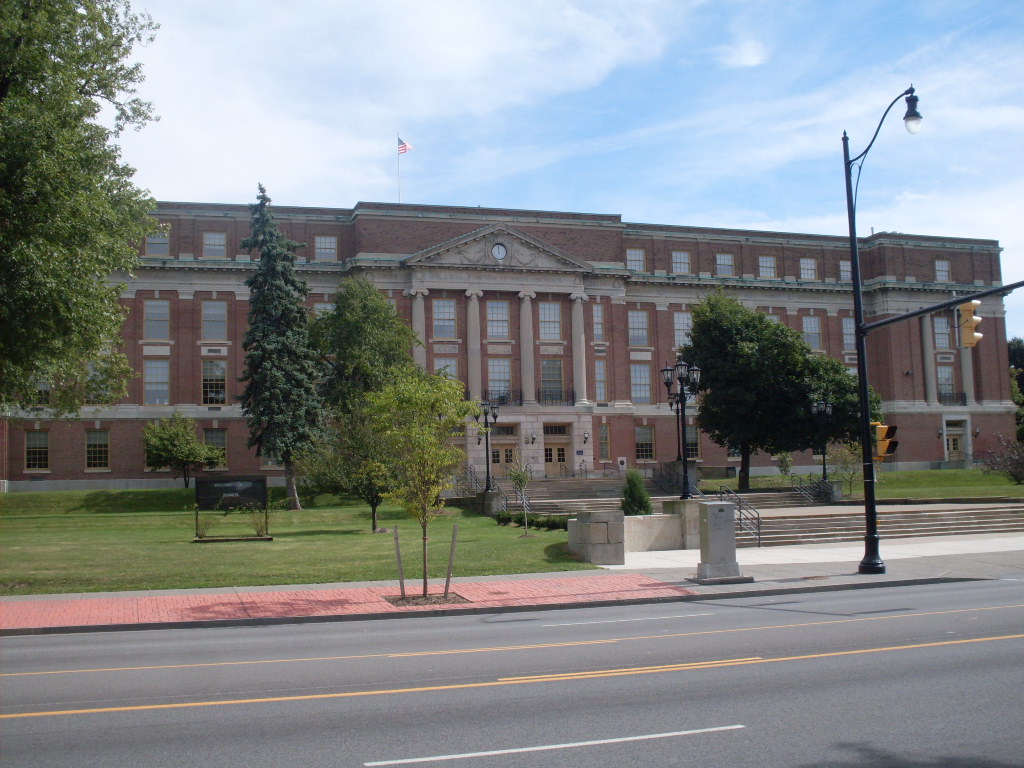
BENNETT HIGH SCHOOL 1933- 1937. Today, Bennett is known as the Lewis J. Bennett High School of Innovative Technology. It is located in an impressive Georgian Revival building, at 2855 Main Street, about a mile from Bob’s home on East Amherst Street. Designed by George Crimi, who used Buckingham Palace as a model, it was built in 1926. “There is no more eloquent architectural statement of the dignity of education anywhere in town.” (Francis R. Kowsky, “Reading Buildings in Buffalo,” in Building Buffalo: Buildings From Books, Books From Buildings, Buffalo & Erie County Public Library, Buffalo NY 2017, p. 61)
Robert developed his love for sports during this time. He lettered in Track, and perhaps other sports as well, since I remember him saying that he practiced a different sport each season. He had an offer to play professional hockey, but turned it down because his father, John, did not want him to be a pro hockey player. Instead, Bob went to University of Michigan. Years later, when his grandson was playing hockey, he said that he thought hockey was a game of chance, rather than skill. Bob never followed the professional leagues on TV.
AT Bennett high, Bob organized a student strike in the cafeteria becasue the school had made a new rule that you couldn’t drink from the water fountain if you didn’t buy lunch, HE was then put on McCarthy’s watch list as a communist. When he tried to get clearance for the federal government years later, he found out he was on the watch list.

He and Lert would make Dagwood sandwiches in the evenings when they were studying. Watching his own sons consume large quantities of food, Bob had stories about how much he and Lert would eat as teenagers. And, yes, there are recipes for Dagwood Sandwiches online today!
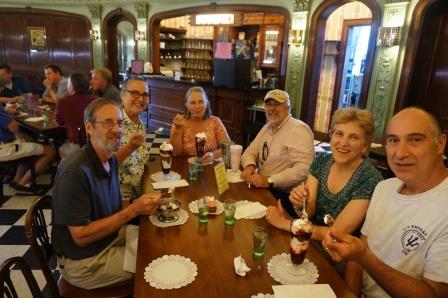
During high school, he worked part-time as a soda jerk –possibly at the Alco on Bailey Ave near East Amherst, though I can find no mention of this shop or its history online. Also, I have a note that he might have worked at the P & R Bakery, though can find no info. about that shop. He definitely worked at the famed and still going strong, Parkside Candy You gotta try their sponge candy! Buffalo is famous for it. He also worked at Freddie’s Donuts. Kris said everybody talked about Freddies. After Sunday mass, the family always enjoyed donuts from Freddies or kuchen….
Photo is from a July 2017 family trip to Parkside. Counter-Clockwise from f: Mike, Carolyn, Marie, Tom, Cynth, Dave.
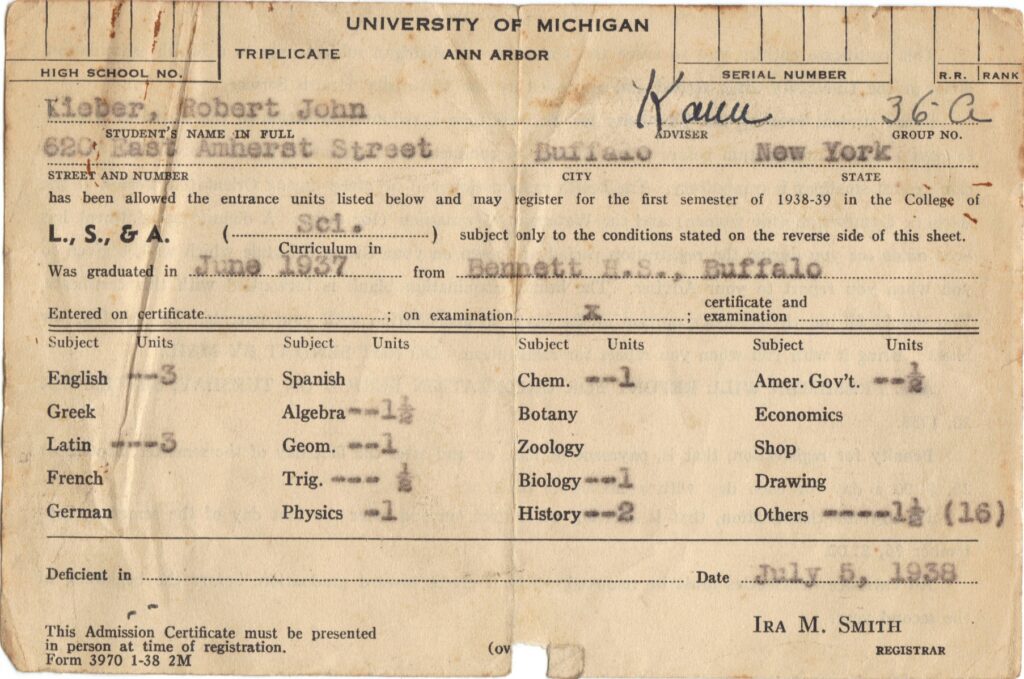
Dad had a 76 on his Latin Regent exam, and a D from Mrs. Daly. The 76 precluded him from entering U of Michigan. His other teachers begged him to drop that teacher. He did not. Instead, Bob graduated Bennett High School on 23 June 1937, he graduating 5th or 6th in his class of 1400 at Bennett. The following evening, he went to work in a bakery. Working shifts from 6 PM to 2 AM, he returned to high school to retake Latin. He got an A. He also received the 2nd highest mark ever in NY regents.
1937-1938 His salary was $32.00 /week. Since he wanted to go to college, the money was carefully put away with only such frivolous things as carfare to be spent. At the end of a year of that work, he was quite certain that he did not want to do “that sort of thing” for the rest of his life.
Tom K-E thinks it was the famous Kaufman’s on East Ferry Street. That closed in 2004. I have some info. that it was the P & R Bakery, which I cannot find any information about.

At any rate, it may have also been FAMOUS DONUTS, which was established in 1938 on East Ferry Street and is still going strong at 3043 Main Street. This was/is located a short walk from Bennett High.

From “How Sweet it Was, A History of Buffalo’s Confectioneries,” (James Walkowiak, Feb 8, 2012 Updated Nov 30, 2020 Buffalo Spree online):
“In terms of sheer street presence, the confectioners of early Buffalo were outdone by few industries. Dozens of entrepreneurs decided to try their hand at confectionery, and, by 1888, when the city directory discriminated for the first time between retailers and wholesalers, the number of confectioners had skyrocketed to 126 retailers and thirteen wholesalers…. What accounts for the boom? Simply put, several technological and scientific developments of the latter 1800s made running a confectionery not only a more exciting enterprise, but a more profitable one, as well. The first development was the invention of new production technologies that allowed American candy makers to begin mass-producing and artfully packaging cheap sweets. Second, scientific discoveries had revealed the principles behind the process of sugar boiling, meaning that candy makers could now control and manipulate the process and, as a result, concoct new and unusual confections. A final development of the time was the refinement of chocolate. Chocolate was rarely used as a confection in the nineteenth century, and it appeared in Buffalo newspaper advertisements for the first time in 1870. When a Dutch scientist discovered how to remove much of cocoa’s naturally occurring fat, chocolate became another tool of the confection trade; confectioneries could now make chocolate bars or use it for coating purposes.”
His brother, Lavern, worked at Alethea’s, which was, in those days, the Garden of Sweets on Bailey Avenue. “Louis Liakeas, proprietor of the original and beloved Garden of Sweets on William Street, taught the business to his son-in-law, Nick Condrell, who had married Liakeas’s daughter Mary. Condrell, considered by many to be the godfather of Buffalo’s modern-day chocolatiers, opened up a second Garden of Sweets on Bailey Avenue and would come out of retirement in the 1960s to open Condrell’s Candies and Ice Cream Parlor on Delaware Avenue in Kenmore.” (Buffalo Spree)
UNDERGRADUATE YEARS ANN ARBOR, Michigan. 1938 – 1942 ( 19 – 22 years old) In 1938 Bob headed to Ann Arbor: the University of Michigan, to major in Zoology.
In addition to his studies, Bob worked all four years to pay his bills. One of his jobs was washing dishes for $.025/hour to defray his lunch costs. Sleep soon became a luxury. He recounted a memory of being in a large lecture hall, sitting in an aisle seat, when he began nodding off… and eventually sliding out of the seat onto the floor and down to the front of the lecture hall.
He said, You can imagine with what delight I looked forward to graduation in 1942!

The 1939 Ann Arbor Directory lists Robert as a student living (renting) at 214 E. William Street.
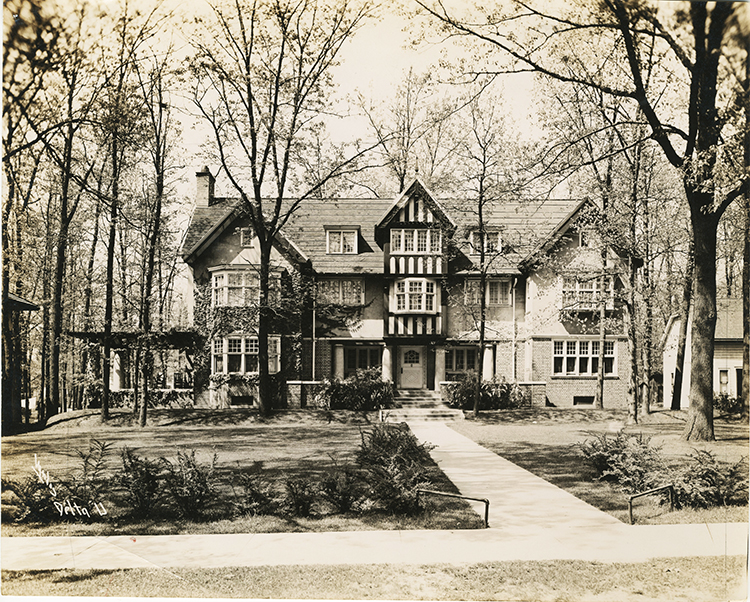
1940 According to the 1940 UM yearbook, Robert became a member of the fraternity, Delta Upsilon, or “Social Fraternity,” the sixth oldest men’s Greek organization. Members are called “oudens.”
“Delta Upsilon was established as a non-secret fraternal organization with an academic orientation. Prominent in the early literature of the society was the motto, “Scholarship must be first for the conscientious student.” The University of Michigan chapter of Delta Upsilon was founded in 1876. ” ([item], folder, box, Delta Upsilon Fraternity, University of Michigan Chapter records, Bentley Historical Library, University of Michigan).
1331 Hill Street, was built in 1903 by Detroit architect, Albert Kahn. Bob said “it was a cheap place to live.”
Evidently though, Robert was not all work. Not only did he continue his life-long passion for sports, he also had his share of dates. The Kieber cousins recalled him bringing home girls to meet the family. They thought he cut quite a dashing figure. And, judging by the picture of him at the time in formal attire, he certainly did!

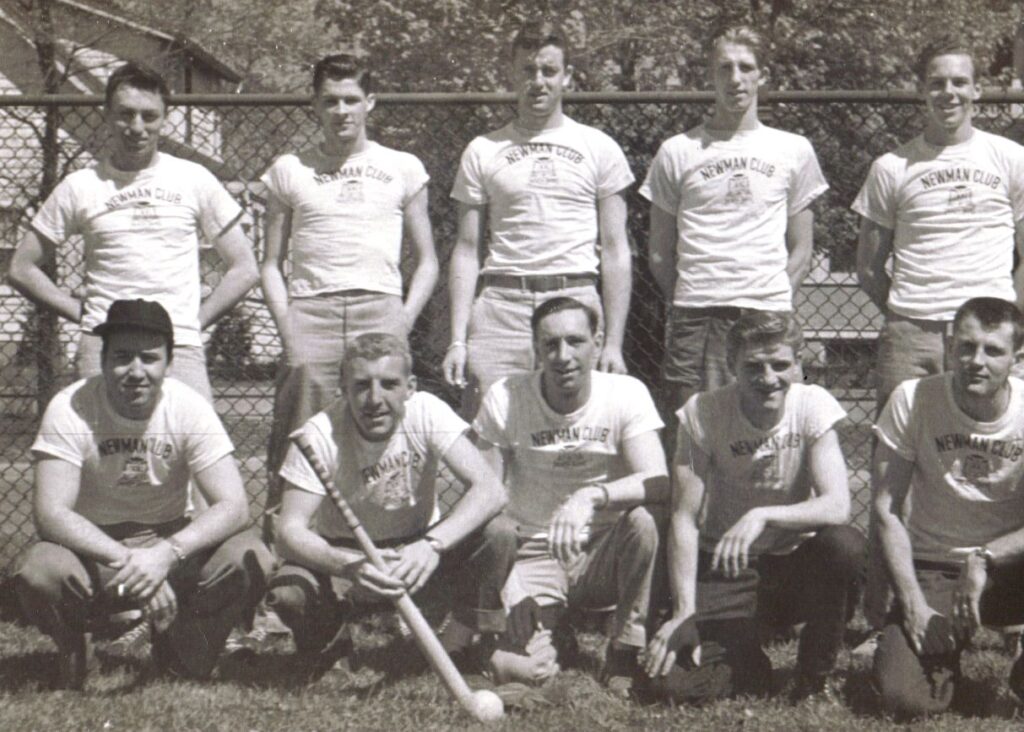
Bob attended St. Mary’s Parish in Ann Arbor (as did several of his daughters many years later). He was active in the growth and formation of the Newman Club at the time. Surprisingly, at least to this writer, the public University of Michigan had been founded in 1817 by a Catholic Priest and a Presbyterian Minister. The year Robert arrived at Michigan, the Newman Club, which had been the Guild of Catholic Students, came into being. This particular Newman Center was intricately tied to the history of the University in Ann Arbor. By 1939, the club had swelled to more than 500 students. Although Bob had gone to a public high school, he came to believe in the importance of Newman Centers as a places for young people, who were naturally questioning their faith, to explore and worship together. Bob became close friends with Henry (Hank) Klauke, who also was active in the Newman Center, and who would go on to arrange a blind date for Bob, and his future wife, Priscilla Lasecki. Hank was dating his future wife, Priscilla’s sis, Gladys.
When daughters, Rabi and Carolyn, were in the Newman Club circa 1975, there were photographs on the wall of early Newman Club students and there was their Dad on the wall –a pic of Bob and Hank playing cards.
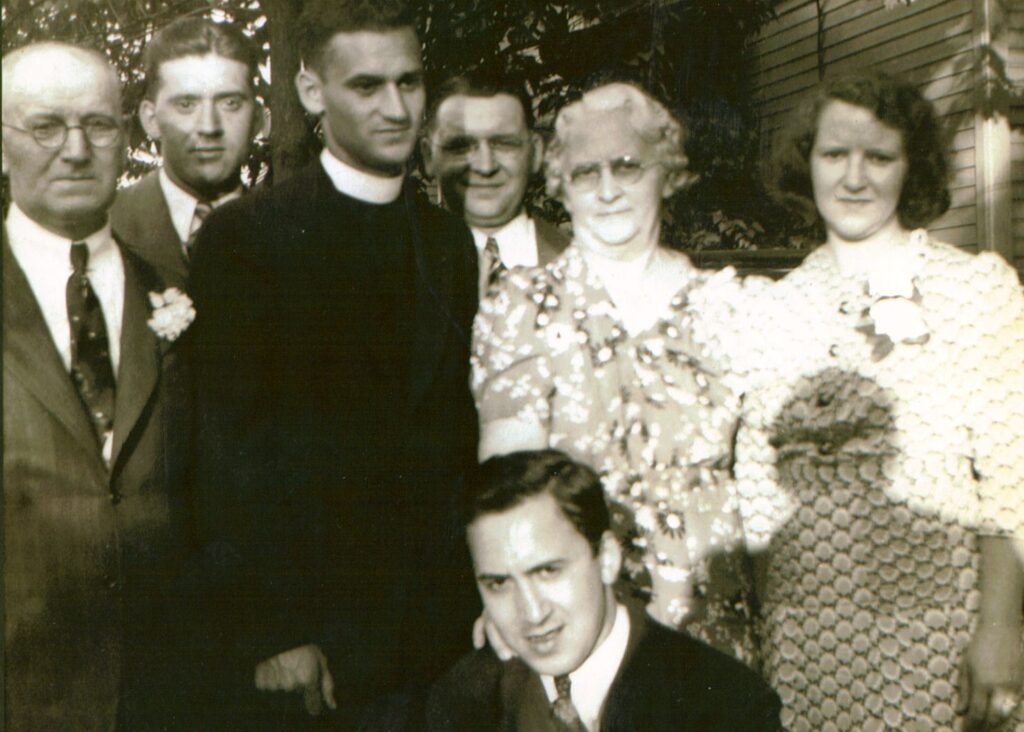
In 1941 and 1942 the Ann Arbor directory lists Robert as a UM student renting a place at 924 East Ann.
1941 was the year that Bob’s brother, Lavern, was ordained a Catholic priest. The entire family gathered together for this sacred, momentous, and proud event. Bob always felt he could not, in his parent’s eyes, live up to the wonderful Lavern. Lavern, it seemed, was everything they wanted in a son. Bob remained, however, close to Lavern his entire life. The photo at right: from R rear: John, Clare, Rev. Lavern Kieber, Raymond, Anna, Buddie. In front is Bob.
Bob received his B. S. degree from U of Michigan at commencement on 30 May 1942.
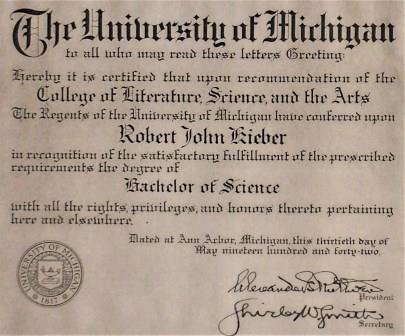
For a fun way to see Buffalo, check out FORGOTTEN BUFFALO TOURS. Let’s get a group together and GO!!!
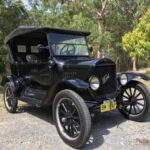
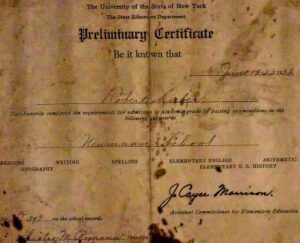
3 Responses